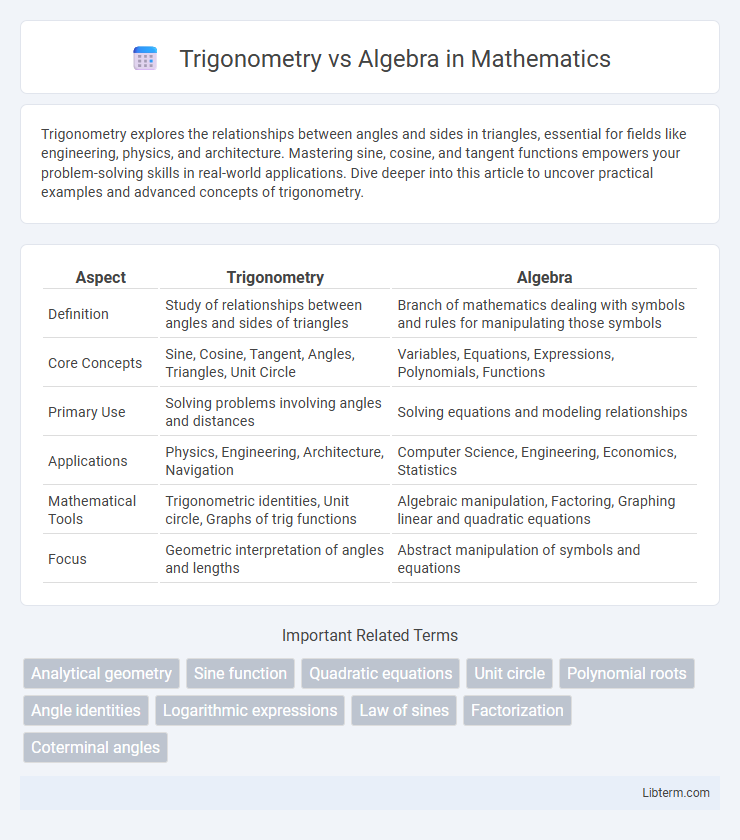Trigonometry explores the relationships between angles and sides in triangles, essential for fields like engineering, physics, and architecture. Mastering sine, cosine, and tangent functions empowers your problem-solving skills in real-world applications. Dive deeper into this article to uncover practical examples and advanced concepts of trigonometry.
Table of Comparison
| Aspect | Trigonometry | Algebra |
|---|---|---|
| Definition | Study of relationships between angles and sides of triangles | Branch of mathematics dealing with symbols and rules for manipulating those symbols |
| Core Concepts | Sine, Cosine, Tangent, Angles, Triangles, Unit Circle | Variables, Equations, Expressions, Polynomials, Functions |
| Primary Use | Solving problems involving angles and distances | Solving equations and modeling relationships |
| Applications | Physics, Engineering, Architecture, Navigation | Computer Science, Engineering, Economics, Statistics |
| Mathematical Tools | Trigonometric identities, Unit circle, Graphs of trig functions | Algebraic manipulation, Factoring, Graphing linear and quadratic equations |
| Focus | Geometric interpretation of angles and lengths | Abstract manipulation of symbols and equations |
Introduction to Trigonometry and Algebra
Trigonometry explores the relationships between angles and side lengths in triangles, using functions such as sine, cosine, and tangent to solve geometric problems. Algebra focuses on manipulating symbols and equations to represent and solve mathematical relationships, including variables, expressions, and polynomials. Both branches form the foundation of advanced mathematics, with trigonometry often applying algebraic methods to analyze spatial and periodic phenomena.
Core Concepts of Trigonometry
Trigonometry revolves around the study of relationships between the angles and sides of triangles, employing functions such as sine, cosine, and tangent to analyze these connections. It is heavily centered on periodic phenomena, wave patterns, and circular motion, distinguishing it from algebra, which primarily deals with abstract symbols and solving equations. Key concepts include radians, unit circle, and the Pythagorean identity, which are foundational for applications in physics, engineering, and computer graphics.
Fundamental Principles of Algebra
Algebra is centered on the manipulation of variables and constants through operations such as addition, subtraction, multiplication, and division, forming the basis for solving equations and inequalities. Its fundamental principles include the use of expressions, equations, functions, and the properties of equality and operations, enabling the representation of real-world problems symbolically. In contrast, trigonometry primarily deals with the relationships between angles and sides of triangles, using functions like sine, cosine, and tangent to solve geometric problems.
Key Differences Between Trigonometry and Algebra
Trigonometry focuses on the relationships between angles and sides of triangles using functions such as sine, cosine, and tangent, while algebra centers on manipulating symbols and solving equations involving variables. Trigonometry is essential for applications in geometry, physics, and engineering that involve angle measurement and periodic phenomena, whereas algebra provides foundational skills for solving linear, quadratic, and polynomial equations. Key differences include the use of trigonometric identities and functions versus algebraic expressions and operations, highlighting their distinct yet complementary roles in mathematics.
Overlapping Areas in Trigonometry and Algebra
Trigonometry and algebra overlap significantly in solving equations involving variables and functions, particularly when working with trigonometric identities such as sine, cosine, and tangent within algebraic expressions. Both fields utilize algebraic manipulation techniques like factoring, expanding, and simplifying to prove identities or solve trigonometric equations. This intersection allows for a comprehensive understanding of periodic functions and their applications in complex problem-solving across mathematics and engineering.
Applications of Trigonometry in Real Life
Trigonometry plays a crucial role in real-life applications such as navigation, engineering, and architecture, where calculating angles and distances is essential for accurate design and construction. Unlike algebra, which focuses on solving equations and understanding relationships between variables, trigonometry applies functions like sine, cosine, and tangent to model periodic phenomena, analyze waves, and optimize structures. Fields such as physics, computer graphics, and astronomy heavily rely on trigonometric principles to simulate motion, analyze forces, and calculate celestial positions.
Practical Uses of Algebra in Everyday Problems
Algebra plays a crucial role in everyday problem-solving by enabling individuals to model situations, such as calculating budgets, determining loan interest, and predicting expenses. It provides the tools to manipulate formulas and equations to find unknown values, making it essential for financial planning and decision-making. Unlike trigonometry, which is often applied in fields involving angles and distances, algebra's versatile applications extend across various daily contexts including shopping, cooking measurements, and time management.
Which Is Harder: Trigonometry or Algebra?
Trigonometry involves understanding the properties and relationships of angles and triangles, often requiring spatial visualization and application of functions like sine, cosine, and tangent, which some students find challenging. Algebra focuses on manipulating equations and expressions involving variables, demanding strong problem-solving skills and logical reasoning that can be difficult in abstract contexts. The perceived difficulty between trigonometry and algebra varies by individual strengths, but trigonometry's reliance on geometric intuition and memorization of identities often makes it harder for learners who struggle with spatial concepts.
Choosing Between Trigonometry and Algebra in Education
Choosing between trigonometry and algebra in education depends on the specific mathematical skills and applications students need to develop. Algebra focuses on manipulating symbols and solving equations, essential for foundational problem-solving across various disciplines, while trigonometry deals with the relationships between angles and sides in triangles, crucial for fields such as engineering, physics, and architecture. Educators should assess curriculum goals and student career paths to determine which branch offers the most relevant and practical knowledge for their academic and professional development.
Conclusion: The Importance of Both in Mathematics
Trigonometry and algebra serve distinct but complementary roles in mathematics, with trigonometry focusing on the relationships between angles and sides in triangles, while algebra deals with solving equations and understanding general mathematical structures. Mastery of both subjects is essential for advanced problem-solving in fields such as physics, engineering, and computer science, where precise calculations and abstract reasoning intersect. Their combined application enhances mathematical literacy and practical skills, driving innovation and analytical thinking across diverse scientific disciplines.
Trigonometry Infographic

 libterm.com
libterm.com